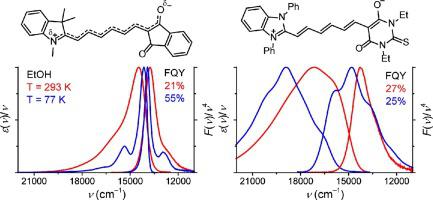Journal of Photochemistry and Photobiology A: Chemistry ( IF 4.1 ) Pub Date : 2020-09-24 , DOI: 10.1016/j.jphotochem.2020.112932 Andrii V. Kulinich , Alexander A. Ishchenko , Stanislav L. Bondarev , Valery N. Knyukshto

|
UV–vis absorption and fluorescence spectra of a series of merocyanines with varying heterocyclic donor and carbonyl-comprising acceptor groups have been studied in frozen ethanol at 77 K. Due to a greater polarity of a frozen solvent matrix in comparison with the liquid solvent, the electronic structure of donor–π–acceptor molecules in the former becomes much more dipolar. The resulting spectral effects depend on the donor–acceptor abilities of the terminal groups. In the case of positively solvatochromic indole-based dyes comprising the 1,3-indandione or barbituric acceptors, going from 293 to 77 K results in a narrowing and bathochromic shifts of absorption bands. Vice versa, for more dipolar reversely and negatively solvatochromic merocyanines comprising the thiobarbituric acceptor-group, the solvent freezing leads to a broadening and hypsochromic shifts of the absorption bands, which is very unique, taking into account that the solute vibrations/rotations should decrease in a frozen solvent. In all cases, the fluorescence bands are shifted hypsochromically at cryo-temperature and are closely mirror-like to the absorption ones, which, along with the smaller Stokes shifts, has been explained by the inhibited solvent rearrangement in the frozen matrix, resulting in a greater similarity of the ground state S0 and the fluorescent excited state S1. The deductions about the electronic structure of the studied dyes in the ground and excited states and its dependence on the donor–acceptor properties of the end-groups correlate well with the results of the PCM/(TD)-DFT calculations performed within the four-level diagram of electronic transitions.
中文翻译:

供体和受体端基对冷冻乙醇中花菁的电子结构和光谱荧光性质的影响
在77 K的冷冻乙醇中,研究了一系列具有不同杂环供体和含羰基受体基团的花菁的UV-vis吸收和荧光光谱。由于与液体溶剂相比,冷冻溶剂基质的极性更大,前者中的供体–π–受体分子的电子结构变得更加偶极。由此产生的光谱效应取决于末端基团的供体-受体能力。在包含1,3-茚满二酮或巴比妥基受体的正溶剂溶变色吲哚基染料的情况下,从293 K变到77 K会导致吸收带变窄和红移。反之亦然,对于包含硫代巴比妥酸受体基团的更多偶极反向和负溶剂溶性变色花青,考虑到溶质的振动/旋转应在冷冻的溶剂中减少,溶剂冻结会导致吸收谱带变宽和变色,这是非常独特的。在所有情况下,荧光带在低温下均会发生蓝移,并与吸收峰呈镜面状,这与较小的斯托克斯位移有关,这是由于冻结基质中的溶剂重排受到抑制而导致的。基态S的更大相似性0和荧光激发态S 1。关于在基态和激发态下所研究染料的电子结构的推论及其对端基供体-受体性质的依赖性,与在以下四个过程中进行的PCM /(TD)-DFT计算结果密切相关。电子转换的电平图。











































 京公网安备 11010802027423号
京公网安备 11010802027423号